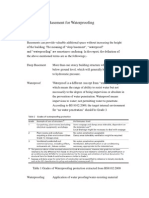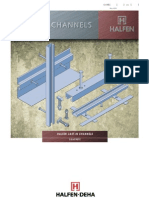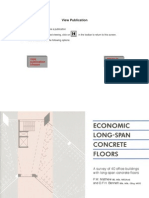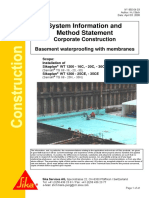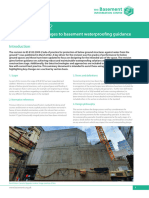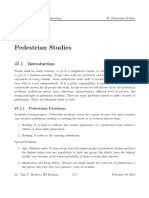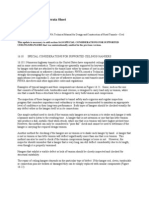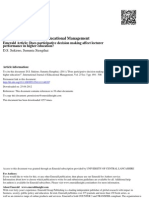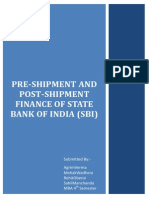Guidance Notes On BS 8102 2009 PDF
Guidance Notes On BS 8102 2009 PDF
Uploaded by
mitnathCopyright:
Available Formats
Guidance Notes On BS 8102 2009 PDF
Guidance Notes On BS 8102 2009 PDF
Uploaded by
mitnathOriginal Title
Copyright
Available Formats
Share this document
Did you find this document useful?
Is this content inappropriate?
Copyright:
Available Formats
Guidance Notes On BS 8102 2009 PDF
Guidance Notes On BS 8102 2009 PDF
Uploaded by
mitnathCopyright:
Available Formats
Summary of BS 8102: 2009
Code of practice for protection of below ground structures
against water from the ground
INTRODUCTION
BS8102:1990 was reviewed by a BS committee Shallow structures are described as being only The waterproofing specialist should
and a revised Standard was published in one storey below ground, and deep structures
November 2009. The main reasons for the describe basements more than one storey a. be suitably experienced
revision are listed as:- below ground level. b. be capable of devising solutions that
accommodate the various project
More deep constructions in congested Section 2 constraints and needs:
urban areas. c. provide the design team with
NORMATIVE REFERENCES
An increase in the provision of residential information and guidance that assist
basements with, and influences the design,
The documents that should be considered in
Development of new materials for conjunction with BS8102: 2009 are listed.
installation and future maintenance
waterproofing of the waterproofed structure.
It is also clear that levels of understanding have
Section 3 The principal considerations for the design
grown as the waterproofing market has TERMS & DEFINITIONS should be assessed. These are set out as
matured. This is reflected in BS8102:2009. follows.
These provide definitions to terms that are
This guidance document is aimed at providing a commonly used in the Code. These should be a) The characteristics of the water
brief overview of the Code but should not be used as source of reference. Amongst the most table, soil and drainage together
used in place of it. All those undertaking significant definitions are:- with other site specific properties
waterproofing work should retain and b) The appropriate waterproofing
familiarise themselves with the full Code of Type A (barrier) protection based on the water table and the
Practice. Protection against water ingress which is uses of the building
dependent on a separate barrier system c) The appropriate type of primary
The PCA also produces its own Code of Practice applied to the structure waterproofing.
of structural waterproofing that works with
BS8102 and provides additional practical Type B (structurally integral) protection The general principals are to assess the risk of
guidance to those involved with waterproofing Protection against water ingress which is water reaching the structure and to select a
below ground structures. provided by the structure waterproofing system capable of achieving the
required environment.
REVIEW & GUIDANCE Type C (drained) protection
The need to understand how any proposed
Protection against water into usable spaces
design works in 3D is emphasized, as is the
Foreword which is provided by the incorporation of an
vulnerability of service openings and
appropriate internal water management
penetrations.
This section of the Code notes the withdrawal system.
of BS8102 1990 and provides the reasons for It is acknowledged that defects can occur in
the production of the new code. Section 4 waterproofing systems as a result of
DESIGN PHILOSOPHY workmanship errors or material characteristics.
Section 1 Understanding the implications of, and the
SCOPE potential for, repairing the waterproofing is
The Code sets out the importance of
also set out.
understanding all the elements that might
This sets out the scope and limitations of challenge the successful use of underground
Fig 1 = Design Flow Chart. This sets out the
BS8102: 2009. Stating that it covers; spaces. This section of the Code is considered
processes that should be adopted when
to be highly important to the PCA and members
planning a robust waterproofing scheme.
a. Waterproofing barrier materials applied of the Structural Waterproofing Group as it
Unfortunately we are unable to reproduce this,
to the structure reinforces the importance of skilled competent
or subsequent figures, in this guidance note.
b. Structurally integral watertight waterproofing specialists.
construction
c. Drained cavity construction The need to establish a cohesive team of Section 5
professionals to assist with the successful SITE EVALUATION
The Code deals with ground water assessment, planning design and execution of a
drainage and associated risk assessments and waterproofing project is highlighted. Section Many of the issues in this section relate to the
buildings partly, and fully, below ground as well 4.2 of the document makes special reference to design of the structure as well as the
as both deep and shallow basements. the inclusion of a waterproofing specialist being waterproofing system.
part of the design team to ensure that an
integrated waterproofing solution is created.
Property Care Association 2013 Structural Waterproofing 1
The code highlights the importance of It is conceded that in some circumstances the
undertaking a desk study to establish the use of drainage can reduce High or Variable
following; water tables to Low conditions.
a) to assess the geology and The Code states the need to inspect existing
hydrogeology, including soil structures carefully before any risk assessment
permeabilities, flood risk, radon, is completed and the waterproofing system is the type of waterproofing system that will be
methane and other ground gases specified or installed. This is essential to ensure adopted.
and contaminants (e.g. chlorides the suitability of the structure for the proposed
and acids); waterproofing and to identify defects or Types ABC are noted as being suitable in new
conditions affecting walls and floors that may construction, with type A and C most suited to
b) to assess the topography of the affect the performance or effectiveness of any existing structures. It is anticipated by the Code
surrounding ground in relation to waterproofing system. that combinations of waterproofing types
the below ground structure; might be best used in specific sites however
Section 6 any problems with compatibility and linking
c) to establish the likely highest level of these types of waterproofing should be fully
WATER- RESISTING DESIGN
the water table and the potential for understood.
the occurrence of a perched water
table; and The code clearly states that:- Table 1 + 2 should be used when selecting the
waterproofing system that is to be used.
d) to identify any missing ground and Waterproofing measures should be designed
groundwater information, which on the basis of water to the full height of the Table 1 plots the water table type against
should then be obtained by retained ground at some time during the varying forms waterproofing. Guidance can be
undertaking a site investigation in structures life where: taken to establish the suitability of each system
accordance with BS 5930 and BS EN when used in these varying ground conditions.
1997. a) no detailed geological or
hydrogeological assessment has Table 2 Sets out the grades of waterproofing
The need to understand the risks associated been undertaken; these revised definitions are set out below.
with the site and the proposed project is
stressed many times within BS8102:2009. In b) the results of the soil investigations Grade 1 - Car parking, plant rooms (excluding
section 5.1.2 it states that- are inconclusive with respect to electrical equipment), workshops. Some
groundwater; seepage and damp areas tolerable, dependent
Risk assessment should also consider: on the intended use
c) the ground drainage characteristics
a) the effects of climate change, burst are unreliable; Grade 2 - Plant rooms and workshops requiring
water mains and sewers, adjacent a drier environment (than Grade 1); storage
trees, sulfates, radon, methane and d) the drainage measures (either areas. No water penetration acceptable. Damp
other ground gases and internal or external) are unreliable areas tolerable; ventilation might be required
contaminants; and or un-maintainable and infiltration
cannot be controlled. Grade 3 - Ventilated residential and
b) where external drainage is commercial areas, including offices, restaurants
proposed, the effects of drawdown This passage is significant because it removes etc, leisure centres. No water penetration
on adjacent structures, the potential any ambiguity that may have surrounded the acceptable. Ventilation, dehumidification or air
silting of drainage and biofouling structural considerations and the expected conditioning necessary, appropriate to the
issues. head of water that can be expected to come to intended use.
bear on the structure.
Even when the site investigation indicates dry The previous edition of this standard referred
conditions, the risk of some water logging (see It is made clear that water from the following to Grade 4 environments however, this grade
Note 2) in the future should be assumed. three sources should be considered and that has not been retained as its only difference
any waterproofing should provide protection from Grade 3 is the performance level related
Water Table Classifications are set out as from -
to ventilation, dehumidification or air
follows;
1) the inflow of surface water, ranging conditioning.
High where the water table or perched water from percolation of rain to
table is assessed to be permanently above the inundation of water from burst The importance of subsurface drainage is set
underside of the base slab. water mains. out in section 6.4 of the Code. This section
looks at the basic characteristics that should be
Low where the water table or perched water 2) the water pressures acting on the
seen in all subsurface drainage used in
table is assessed to be permanently below the external retaining wall system;
conjunction with underground waterproofing.
underside of the base slab. This only applies to
free-draining strata. 3) the water pressures below the base
slab. The position of land drains below the base slab
Variable where the water table fluctuates. is shown in Fig 3 and the importance of
It is anticipated that following these evaluations installing maintainable drainage systems is
and risk assessments, a decision will be made emphasized.
on
Property Care Association 2013 Structural Waterproofing 1
The insertion of a ground barrier for the Section 11
prevention of radon, methane and other REMEDIAL MEASURES
ground gases and contaminants from entering
an underground structure is drawn to the The issue of reparability is featured several
readers attention, as are Building Regulations times throughout BS8102: 2009. Section 11
[3] and BS 8485. examines the processes that can be adopted in
assessing the form and feasibility of repairs to a
Section 7 defective waterproofing system.
GENERAL CONSTRUCTION ISSUES
The information in this leaflet is given in good
faith and is believed to be correct, but since the
This short section of the Code provides general
methods of use of moisture meters and the
information on dewatering a site during the
construction phase of a project and also defines interpretation of their readings are beyond the
the types of structural elements that are suited control of the Association, it does not accept
to waterproof design. responsibility for any loss, howsoever arising,
resulting from a reliance on the information
Structural elements are described below. contained in this leaflet or involving the use of
moisture meters.
Walls constructed from:
SW/0509
1) masonry (plain or reinforced brick or
block);
2) precast concrete; For further information contact:
3) in-situ concrete, either cast in form
(plain, reinforced or pre-stressed) Property Care Association
or embedded walls; or 11 Ramsay Court
4) steel or concrete piles in embedded
walls.
Kingfisher Way
Hinchingbrooke Business Park
Base slab constructed from concrete cast in- Huntingdon
situ, plain or reinforced, raft or other form. Cambs
Roof, where applicable constructed from
PE29 6FY
reinforced in-situ concrete, precast concrete Tel: 0844 375 4301
with an in-situ topping, or a steel composite Fax: 01480 417587
slab, as appropriate. Email: pca@property-care.org
Web: www.property-care.org
Section8
TYPE A (BARRIER) PROTECTION
The Property Care Association is a division of
Section 9 the British Wood Preserving and Damp-
proofing Association, a company limited by
TYPE B (STUCTURAL INTEGRAL) Guarantee: Registered No. 3280875 England
PROTECTION
Section 10
TYPE C (DRAINED) PROTECTION
These sections of the code describe the uses
and characteristics of the three types of
waterproofing that are featured. The text
provides information on how they perform and
gives an indication of the inherent strengths
and weakness associated with each form of
waterproofing.
BS8102; 2009 no longer provides information of
the practical; application of use of each system.
The user of the code is referred to the supplier
or manufacturer of the waterproofing products
for this information.
Property Care Association 2013 Structural Waterproofing 1
You might also like
- BS 8298-5 2023 Design and Installation of Natural Stone Cladding and Lining. Traditional Handset Internal Cladding. Code of PracticeDocument86 pagesBS 8298-5 2023 Design and Installation of Natural Stone Cladding and Lining. Traditional Handset Internal Cladding. Code of Practicea41rv1ngNo ratings yet
- BS 05385-3-2014Document96 pagesBS 05385-3-2014george antwanNo ratings yet
- BRE128 - Guidelines For The Construction of Fire Resisting Structural ElementsDocument47 pagesBRE128 - Guidelines For The Construction of Fire Resisting Structural ElementscapeprengNo ratings yet
- BS 05234-1-1992 (1999) Partitions (Including Matching Linings) - Code of Practice For Design and Installation.Document38 pagesBS 05234-1-1992 (1999) Partitions (Including Matching Linings) - Code of Practice For Design and Installation.ironface100% (2)
- Ciria Report 91 1981 PDFDocument19 pagesCiria Report 91 1981 PDFimranmehfoozNo ratings yet
- Pas 00024-2012Document92 pagesPas 00024-2012Emre ÖzaydınNo ratings yet
- (G15) BS 8000 Part 2-2 1990Document24 pages(G15) BS 8000 Part 2-2 1990sawmyo2007No ratings yet
- BS 8103 Part 1-2011Document66 pagesBS 8103 Part 1-2011Peter ChanNo ratings yet
- Clay Roofing Tiles and Fittings - Product Definitions and SpecificationsDocument32 pagesClay Roofing Tiles and Fittings - Product Definitions and Specificationschwkim38100% (1)
- BS 6262 3 2005 Glazing For Buildings Code of Practice For Fire Security and Wind Loading PDFDocument40 pagesBS 6262 3 2005 Glazing For Buildings Code of Practice For Fire Security and Wind Loading PDFAvinaash Veeramah100% (2)
- Architectural Precast Concrete Sealant and Joint GuideDocument36 pagesArchitectural Precast Concrete Sealant and Joint GuideCarlo Dizon100% (2)
- Technical Guidance Notes (Level 1) - ContentsDocument1 pageTechnical Guidance Notes (Level 1) - ContentsEduard KovalevskijNo ratings yet
- (G58) BS 06398-1983 (1999)Document10 pages(G58) BS 06398-1983 (1999)sawmyo2007100% (1)
- (G16) BS 8000 3 2001Document34 pages(G16) BS 8000 3 2001sawmyo2007No ratings yet
- BS 8102-1990Document40 pagesBS 8102-1990Brian Li100% (5)
- Bs4873 - Specification For Aluminium Alloy WindowsDocument18 pagesBs4873 - Specification For Aluminium Alloy WindowsquangxuantranNo ratings yet
- Titles: Form Face Calculation Basis Formwork Guide To Good Practice 2nd Edition - Load Case 58 Design DataDocument1 pageTitles: Form Face Calculation Basis Formwork Guide To Good Practice 2nd Edition - Load Case 58 Design DataArmen Abizar100% (1)
- BS8500 BS8110Document8 pagesBS8500 BS8110Ahmed Mostafa AL-Aboudy100% (1)
- Concrete Society - Concrete Advice No 26 - RC Bund StructuresDocument3 pagesConcrete Society - Concrete Advice No 26 - RC Bund StructuresKarishma JuttunNo ratings yet
- Design Manual-Stone Cladding FixingsDocument6 pagesDesign Manual-Stone Cladding FixingsvtalexNo ratings yet
- BS 8414Document18 pagesBS 8414amanduhqsm100% (2)
- Basement Grade & WaterproofingDocument18 pagesBasement Grade & WaterproofingjparsbNo ratings yet
- Newton BS 8102 2022 Technical Paper Apr22Document19 pagesNewton BS 8102 2022 Technical Paper Apr22nandanaNo ratings yet
- Why The BS 8500 Durability Tables Are The Way They Are-Concrete June2016Document4 pagesWhy The BS 8500 Durability Tables Are The Way They Are-Concrete June2016Vipin Kumar ParasharNo ratings yet
- Guide To The Specification & Application of Screeds: The Resin Flooring AssociationDocument16 pagesGuide To The Specification & Application of Screeds: The Resin Flooring Associationmoizm53100% (1)
- Concrete BasementsDocument185 pagesConcrete Basementsrbashir6100% (1)
- Construction JointsDocument4 pagesConstruction JointsLilibeth CastroNo ratings yet
- Sika Solutions For Watertight Basement StructureDocument32 pagesSika Solutions For Watertight Basement StructureDimas SaputraNo ratings yet
- Movement Joints PDFDocument12 pagesMovement Joints PDFnilminaNo ratings yet
- BS 8204-4-1993-In-Situ Floorings-Code of Practice For TerrazDocument22 pagesBS 8204-4-1993-In-Situ Floorings-Code of Practice For Terrazgops1963100% (1)
- British Standards 2006 PDFDocument21 pagesBritish Standards 2006 PDFYongsub JungNo ratings yet
- The Advantages of Using EurocodesDocument2 pagesThe Advantages of Using EurocodesakankwasaNo ratings yet
- Design of Deep Basement For Waterproofing ReportDocument16 pagesDesign of Deep Basement For Waterproofing Reportlpcgby27100% (1)
- Architect Guide enDocument10 pagesArchitect Guide enmcNo ratings yet
- BS 5516-1 2004Document68 pagesBS 5516-1 2004Robert CoelhoNo ratings yet
- Introduction To Eurocode 6 - MasonryDocument8 pagesIntroduction To Eurocode 6 - Masonrydddddd2013100% (1)
- Water Resistance BasementDocument6 pagesWater Resistance BasementGabby KenNo ratings yet
- Minimum Horizontal Imposed Loads For Parapets, Barriers and Balustrades, Etc - Morris Fabrications LTD - Architectural MetalworkersDocument6 pagesMinimum Horizontal Imposed Loads For Parapets, Barriers and Balustrades, Etc - Morris Fabrications LTD - Architectural MetalworkersJeya Keeshan J KNo ratings yet
- BS8007 Design For Concrete Retaining Structures For Aqueous LiquidsDocument38 pagesBS8007 Design For Concrete Retaining Structures For Aqueous Liquidsdawg1503No ratings yet
- Halfen Castin Channel FixingsDocument40 pagesHalfen Castin Channel Fixingspodrow100% (1)
- BS 5628-3Document136 pagesBS 5628-3Leed EN100% (5)
- Economic Long Span Concrete Floor SlabsDocument51 pagesEconomic Long Span Concrete Floor Slabsocenkt100% (10)
- Crack Control in Concrete Masonry WallsDocument4 pagesCrack Control in Concrete Masonry WallsAnonymous Re62LKaACNo ratings yet
- Handrail Design Standard PDFDocument6 pagesHandrail Design Standard PDFereresrdfNo ratings yet
- MPI Architectural Painting Manual: Guide Specification Revision - September 2012 Section 09900 Painting Page 1 of 28Document28 pagesMPI Architectural Painting Manual: Guide Specification Revision - September 2012 Section 09900 Painting Page 1 of 28Alsayed DiabNo ratings yet
- Evolution of ACI 562 Code Part 3Document7 pagesEvolution of ACI 562 Code Part 3Ziad BorjiNo ratings yet
- Façade Design Life Datasheet V2Document1 pageFaçade Design Life Datasheet V2ManishMokalNo ratings yet
- CP 00102-1973 (1999)Document34 pagesCP 00102-1973 (1999)Stanislav PerevezentsevNo ratings yet
- Hilti HCC-B For Concrete Overlays: Fastening Technology ManualDocument39 pagesHilti HCC-B For Concrete Overlays: Fastening Technology ManualPablo Martinez FesserNo ratings yet
- No. 6 Fire Design of Concrete Columns and Walls To Eurocode 2Document6 pagesNo. 6 Fire Design of Concrete Columns and Walls To Eurocode 2spid003No ratings yet
- Foundations Lighting Columns PDFDocument2 pagesFoundations Lighting Columns PDFtexas_peteNo ratings yet
- Basement Waterproofing Sikaplan WTDocument45 pagesBasement Waterproofing Sikaplan WTMartin Urbieta100% (1)
- British Standards and Codes of Practice For The Installation of Wall Floor TilesDocument13 pagesBritish Standards and Codes of Practice For The Installation of Wall Floor TilesmohammadNo ratings yet
- TechnicalData Cladding Stones PavingDocument20 pagesTechnicalData Cladding Stones PavingCharles FernandesNo ratings yet
- Time-dependent Behaviour and Design of Composite Steel-concrete StructuresFrom EverandTime-dependent Behaviour and Design of Composite Steel-concrete StructuresNo ratings yet
- BS 8102.2022 An Overview of Changes To Basement Waterproofing GuidanceDocument4 pagesBS 8102.2022 An Overview of Changes To Basement Waterproofing GuidanceDavid O'MearaNo ratings yet
- TMP 28651-Dpcpractice191599424 PDFDocument4 pagesTMP 28651-Dpcpractice191599424 PDFmoukhNo ratings yet
- Condensation Management Changes NCC 2019Document3 pagesCondensation Management Changes NCC 2019matt.greeneNo ratings yet
- Waterproofing Memo NCCDocument3 pagesWaterproofing Memo NCCm96xbdtjmqNo ratings yet
- Guide To Wet Area WaterproofingDocument43 pagesGuide To Wet Area WaterproofingpanadiumNo ratings yet
- GammonBulletinAPRIL JUNE2014 PDFDocument20 pagesGammonBulletinAPRIL JUNE2014 PDFmitnathNo ratings yet
- Cete 47 PDFDocument20 pagesCete 47 PDFTangha Muklom KunchaNo ratings yet
- Is 460 - 1 Wire Cloth Test Seives 1985 2013Document16 pagesIs 460 - 1 Wire Cloth Test Seives 1985 2013mitnathNo ratings yet
- Tandon Consultants InfoDocument41 pagesTandon Consultants Infomitnath100% (1)
- Shock Transmission Units For Bridges - IndiaDocument3 pagesShock Transmission Units For Bridges - IndiamitnathNo ratings yet
- Tunnel ManualDocument704 pagesTunnel ManualGianMaria Zucchini100% (4)
- Dr. Songkiat-Handout Precast Segmental Construction TechnologyDocument25 pagesDr. Songkiat-Handout Precast Segmental Construction TechnologymitnathNo ratings yet
- Lifting Frames & Launching GirdersDocument34 pagesLifting Frames & Launching GirdersMahmood Mufti100% (2)
- M e Thesis Waterproofing of Underground Structures Tim BigginsDocument115 pagesM e Thesis Waterproofing of Underground Structures Tim BigginsmitnathNo ratings yet
- Rdso Seismic Design 2015 NovDocument90 pagesRdso Seismic Design 2015 NovmitnathNo ratings yet
- SC Vtol 01Document31 pagesSC Vtol 01Soma VargaNo ratings yet
- Aspartame MSDSDocument6 pagesAspartame MSDSHuongThi KhongNo ratings yet
- xiaomi brand auditDocument3 pagesxiaomi brand audithanswalter816No ratings yet
- Excel T01Document47 pagesExcel T01AlexandraNo ratings yet
- Catalase: Catalase Is A Common Enzyme Found in Nearly All LivingDocument12 pagesCatalase: Catalase Is A Common Enzyme Found in Nearly All Livinghasan jamiNo ratings yet
- MEMORANDUM OF AGREEMENT To JUNK SHOPDocument3 pagesMEMORANDUM OF AGREEMENT To JUNK SHOPbarangaysancarlosofficial100% (1)
- How You Can Precommission Process Plant Systematically PDFDocument6 pagesHow You Can Precommission Process Plant Systematically PDFRobert MontoyaNo ratings yet
- 7 MathsDocument3 pages7 MathsMayur ChhagNo ratings yet
- A Web-Based Enrollment Management System For Paisley Garden AcademeDocument2 pagesA Web-Based Enrollment Management System For Paisley Garden AcademeAngela Louise TomasNo ratings yet
- Datasheet NARADA 12NDF155 PDFDocument2 pagesDatasheet NARADA 12NDF155 PDFDavid Esteban100% (1)
- Southwest Airline Case StudyDocument4 pagesSouthwest Airline Case Studydale_938841649No ratings yet
- Ore Genesis: From Wikipedia, The Free EncyclopediaDocument10 pagesOre Genesis: From Wikipedia, The Free EncyclopediaJoseph MofatNo ratings yet
- Deped Form 6Document2 pagesDeped Form 6Vianne SebucoNo ratings yet
- Activity 2aDocument6 pagesActivity 2aAndy ReiNo ratings yet
- An Analysis of The Financial Performance of National Bank Limited Using Financial RatioDocument9 pagesAn Analysis of The Financial Performance of National Bank Limited Using Financial RatioKathryn TeoNo ratings yet
- Does ParticipativeDocument16 pagesDoes ParticipativeMuhammad Yasir KasuriNo ratings yet
- MachineDocument13 pagesMachineashu0990% (2)
- Emaar Land Registration Title Deed FactsheetDocument3 pagesEmaar Land Registration Title Deed FactsheetHassan AliNo ratings yet
- Smart Dog TR P5Document5 pagesSmart Dog TR P5marco silveiraNo ratings yet
- Hydrogen SulfideDocument151 pagesHydrogen SulfidereddygrNo ratings yet
- High Frequency Power Transformers - Design A High-Frequency Power Transformer Based On Flyback TopologyDocument6 pagesHigh Frequency Power Transformers - Design A High-Frequency Power Transformer Based On Flyback TopologyShyam Bin Jamil100% (2)
- ResultsDocument12 pagesResultsarnoldtikus2No ratings yet
- MOU MurdochDocument1 pageMOU MurdochRikho Melga ShalimNo ratings yet
- UCTE IC Final Report Black Out in ItalyDocument128 pagesUCTE IC Final Report Black Out in ItalycarlosmandopintoNo ratings yet
- An Introduction To Financial System, Its Components: Unit 1Document16 pagesAn Introduction To Financial System, Its Components: Unit 1bhavyaNo ratings yet
- Seismic Response of RC Structures Subjected To Simulated GroundDocument18 pagesSeismic Response of RC Structures Subjected To Simulated GroundUrsu Claudiu AntonNo ratings yet
- Pre-Shipment and Post-Shipment Finance of State Bank of India (Sbi)Document5 pagesPre-Shipment and Post-Shipment Finance of State Bank of India (Sbi)Rohit OberoiNo ratings yet
- 1 PDFDocument41 pages1 PDFChan Peng SwanNo ratings yet
































